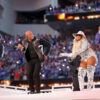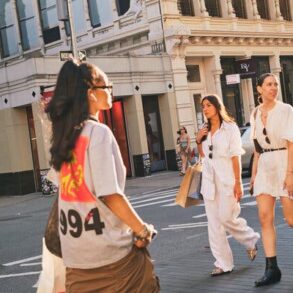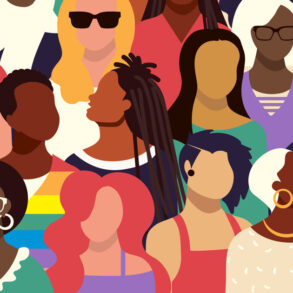The third in a series of five Retropolis stories looking back at moments in hip-hop history during the week of the music genre’s 50th anniversary.
What ended as the day that hip-hop was born began hours before with Cindy Campbell hoping she could buy some new clothes to impress her classmates.
Campbell thought the fastest and most fun way to upgrade her wardrobe, and bring joy to the Bronx during a period of despair, was to throw a back-to-school party in the recreation room at 1520 Sedgwick Ave. But as the expenses kept piling up in August 1973 — renting out the room for $25, buying hot dogs and soda wholesale, supplying bottles of malt liquor — Campbell, then 15, knew the “Back-to-School Jam” would flop unless she found a musical act that she could afford.
It’s why she turned to her 18-year-old brother, Clive, whom the community knew as DJ Kool Herc. She knew him as having a booming sound system in his room and being the cheapest music option available for a party on Aug. 11, 1973, that was charging admission of 25 cents for girls and 50 cents for boys.
“I’m thinking, ‘How can I cut my costs?’ … When you have your party, you got to have the music. So I said, ‘It’ll be free because I don’t have to pay for it.’” Campbell, now 65, recalled in a 2021 interview with the Breakdown FM podcast. “I was cutting costs!”
The cost-cutting measure brought about something else that night inside a packed, sweaty rec room of dancing youths: what’s widely regarded as the birth of an art form the world would come to know as hip-hop.
“At the time, the gangs were terrorizing the house parties and stuff, so we asked, ‘Could we give a party?’” Herc said in the Netflix series “Hip-Hop Evolution.” “They liked what I was playing and the rest is history.”
Herc saw how the scene was hopping during any song’s break — usually the drumbeat or rhythm interludes of soul and funk records — and the DJ went from one record’s break to another, much to the delight of the crowd. It’s a legacy that paved the way for hip-hop over the next half-century, Dan Charnas, a historian and author of the 2010 book “The Big Payback: The History of the Business of Hip-Hop,” told The Washington Post.
“When we commemorate Aug. 11, 1973, what we’re saying is that the break is the most important or fundamental genius of hip-hop,” Charnas said. “Hip-hop arises out of that particular moment of inspiration.”
Added Kevin Powell, a hip-hop historian and curator of the first exhibit chronicling the genre’s history in America: “It is the watershed moment for the birth of hip-hop.”
Artists and fans from around the world are celebrating hip-hop’s 50th anniversary on Friday with shows, exhibits, playlists and re-listening to albums and artists who helped shape a culture through samples, shout-outs and collaborations. The milestone has also earned praise from unexpected sources, such as Senate Majority Leader Charles E. Schumer (D-N.Y.), who had worked with Herc to save 1520 Sedgwick Ave. from being torn down.
“Hip-hop has transcended language, race, age, both geographic and socioeconomic barriers,” Schumer said last month following the passage of the Schumer-Cassidy resolution recognizing hip-hop’s 50th anniversary. “Many people can attest to the fact that hip-hop actually changed their lives for the better, gave them purpose and meaning.”
‘When Kool Herc give a party, everybody be there!’
As people celebrate the anniversary, many are taking the time to thank the sister and brother from the Bronx whose party helped make hip-hop happen.
“Having no Kool Herc or Cindy Campbell in the history of hip-hop is like not having Chuck Berry and Little Richard in rock-and-roll, Louis Armstrong and Billie Holiday in jazz, not having the Beatles in the British invasion,” Powell, a poet who is writing a biography about Tupac Shakur, told The Washington Post. “People need to understand that.”
A few years after the Campbells emigrated from Jamaica, they were among the Bronx residents living in a borough that had been devastated by poverty, urban decay and arson fires in the 1970s. By November 1972, the New York Times had analyzed census data and found that the Bronx had experienced “the smallest slice of prosperity and the largest proportion of poor families among the 19 counties of the tri-state metropolitan region and among all 62 counties of New York State.”
“It was lot of graffiti, a lot of crime and massive poverty,” said Powell, who grew up in Jersey City but had relatives in the borough. “The Bronx got the bulk of the abandonment.”
As Herc was starting to make a name for himself as a DJ in the community, his sister created handwritten fliers and notecards promoting the party that would go from 9 p.m. until 4 a.m. Campbell’s job with the neighborhood Youth Corps didn’t offer the kind of pay she needed to get the clothes she wanted on Manhattan’s Delancey Street, she said at 2020 event. She’d sell soda at the party for 50 cents, hot dogs for 75 cents and Olde English or Colt 45 malt liquor for a $1 each, Campbell recounted to Rock the Bells in 2020.
“For me, just to put the whole thing together, that was the best part,” Campbell said in 2020.
By the time the party got underway, the crowd had come to see Herc, whose loud system was an attraction for young people. He later proclaimed in “Beat This!,” a 1984 BBC documentary: “When Kool Herc give a party, everybody be there!”
“Everybody put on their best that day,” Herc recounted in the documentary about Aug. 11, 1973.
‘Excitement and a little bit of danger’
At that time, Coke La Rock thought of himself as more of a marijuana dealer than an MC. He believed performing alongside DJs such as Herc “wasn’t fashionable,” so he brought dozens of nickel bags to sell.
“I figured that would go good with the party,” he said to VladTV in 2021.
But as the party progressed and intensified with the seemingly endless string of breaks, Herc had to give the people what they wanted.
“I didn’t have headphones at the time, but I could see the breaks on the record’s grooves and just went back and forth,” he told Grammy.com last month. “Once the dancers heard that, all they wanted to hear were the breaks.”
La Rock saw what Herc was doing and ran with it.
“As the party got bigger, my talk got bigger,” he said in 2020.
After that first jam, attending a Herc party felt “really surreal,” rapper Melle Mel recalled to Netflix.
“Back then we were smoking some weed and some angel dust, it’s just loud, booming music, it’s kind of dark and smoky,” he said in 2020. “It was just a vibe that Herc had — [there] was excitement and a little bit of danger.”
Rapper Kurtis Blow echoed that sentiment, recalling one Herc party that had him sticking his head next to the bass speaker and closing his eyes, “and the bass would just rumble all through my body, all the way down to my toes.”
“Herc, he was a revolutionary,” Blow said to Netflix. “He revolted. He did not want to play the disco music we heard on the radio. He wanted to give us the music that we grew up on — the soul music. And it was incredible because in a world of disco here is this DJ coming out playing this special kind of music. And this was so important to the birth of hip-hop, that we’re going to be playing funk music.”
The success of that first party spawned other jams in the Bronx that summer, which eventually got the attention of Grandmaster Flash after someone talked about a party they attended featuring a “slammin’ DJ with a killer sound system,” according to the 2008 autobiography “The Adventures of Grandmaster Flash: My Life, My Beats,” co-written by David Ritz.
“This wasn’t yet a genre of music, it was just parties. These people throwing parties was just part of the culture,” Carnas told The Post. “People who came after Herc like Flash took the idea and made it usable, replicable and musical.”
Even after Herc was regarded as one of hip-hop’s founding fathers years later, some casual or newer fans of the genre might not know what he or his sister did 50 years ago. Those who do know are honoring them in their own way. Carnas said he’ll be at the “Hip Hop 50 Live” show at Yankee Stadium in the Bronx, featuring headliners like Run-DMC, Snoop Dogg and Ice Cube.
Powell is planning to go to 1520 Sedgwick Ave. He admitted he’ll probably cry while reflecting on the art form that shaped him and generations of others — one that started with a simple back-to-school party.
“We need to understand that hip-hop not only transformed America but also transformed the world,” Powell said. “And it’s because of the vision Kool Herc and Cindy Campbell had 50 years ago.”







